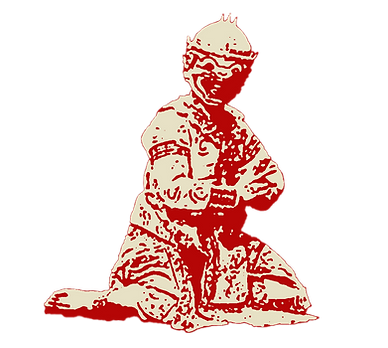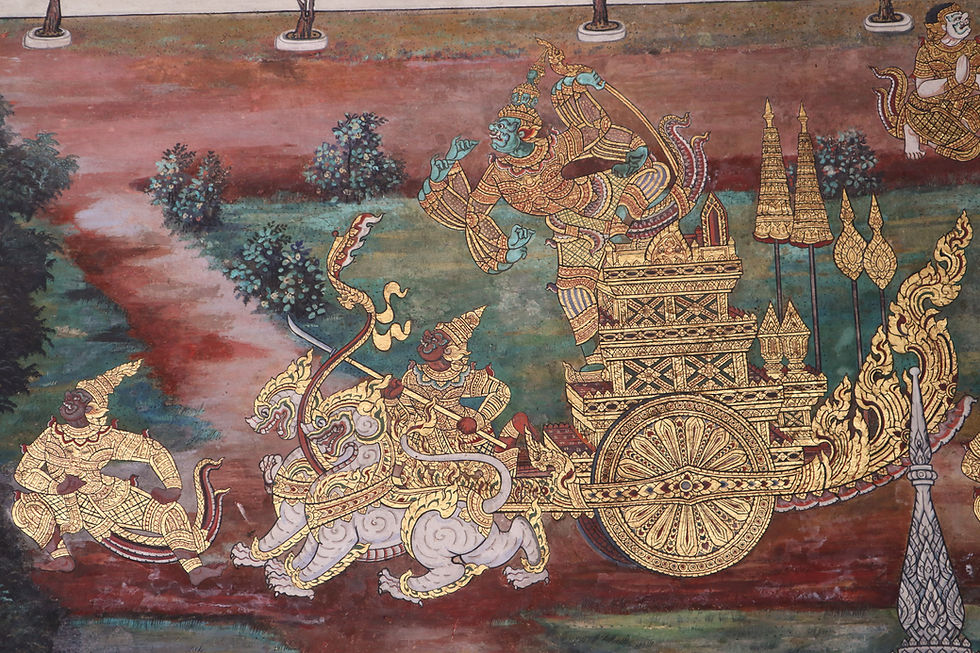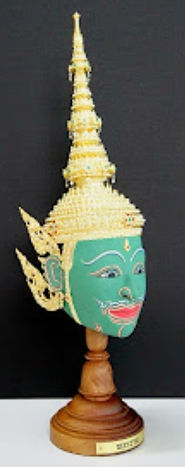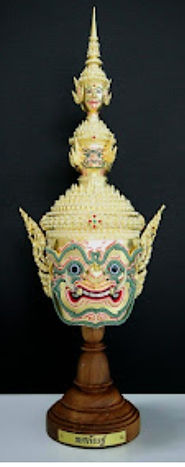Khon
Characters & Costumes
Now that we’ve explored the background of the cultural dance and its story, let’s delve deeper into the makings of this traditional artform! So, what truly encapsulates the essence of Khon? Is it the meticulously crafted masks adorning the performers, or perhaps the elaborate costumes which glimmer as they move on stage? These artistic facets, often overshadowed by the grandeur of a performance, are the result of painstaking work by artisans who inherit the secret techniques from their ancestors. As we travel through time and unravel the mysteries of the past methods, let’s also compare the present day’s efforts of keeping Khon alive and authentic!
Characters in Khon
In Khon, which tells the story of Ramakien, the roles are divided into 4 main categories:
-
Phra (lords, or human males)
-
Nang (ladies, or human females)
-
Yak (ogres/giants)
-
Ling (monkeys)
Additionally, there are also some minor characters such as hermits, deities and other beings. (Thailand Foundation, 2021)

Can you identify the character in the image below?

The answer is Hanuman, the god-king of monkeys and Phra Ram’s ally!
We can tell because of the predominantly white costume and red detailing, which juxtaposes against the green of both the protagonist and antagonist in Khon. Hanuman's character injects a sense of humor and playfulness to the performance, offering a refreshing contrast to the intense drama unfolding on stage (Chloe, 2023).
Khon performer. Image: Choo Yut Shing, 2015. ( Masters of Craft : Khon masks of Thailand (masters-craft.blogspot.com) )
What is the significance of traditional costumes in Khon?

For the Audience to Identify Characters on Stage
Visual Representation of Thai Culture
Traditional costumes serve as a link to the past

Behind the Mask
Here’s a fun fact! In Thai, “Phra” can be translated to “holy”. The main character, Phra Ram, is the symbol of virtue and righteousness, and thus is sometimes portrayed with a golden mask (Chloe, 2023). Ramakien is the Thai version of the Hindu epic tale of Ramayana, where Phra Ram parallels the character Rama, the incarnation of Vishnu. While Rama is traditionally depicted with blue skin, Thai culture portrays Phra Ram with green skin.
Nang Sida, his wife, embodies purity and devotion, while Hanuman represents strength and bravery. Khon cleverly uses character symbolism in the design of costumes. The antagonist is Tosakanth, the demon King, depicted with a fearsome green mask, representing his malevolence. He is a powerful and cunning character, relentless in his pursuit of his goal: capturing Nang Sida and making her his wife. (Chloe, 2023)
Did you know that the most striking feature of Khon is the masks worn by the performers? There are about 311 characters across all 138 episodes of Ramakien (Rani, 2015), which means 311 different masks – all intricately detailed to communicate the essence of each role.

A mask of Rama. Image: Olga Rani, 2015 ( https://masters-craft.blogspot.com/2015/10/crafts-of-thailand-khon-masks.html )

A mask of Thosakanth. Image: Olga Rani, 2015 ( https://masters-craft.blogspot.com/2015/10/crafts-of-thailand-khon-masks.html )
How do the masks embody a character's persona?
Through color and nuanced features! Some distinguishing elements of the mask include the eyes, which can be bulging or crocodile-like, and the mouths, which can be clamping or snarling. The combination of such ornate details serve to accentuate the roles. For example, Tosakanth sports a fierce, snarling expression, with a two-tiered crown on top of the main head to represent his ten faces and divinity. On the other hand, Phra Ram’s mask exudes a benevolent majesty. It is crafted with delicate features which are clearly human, with a faint smile that mirrors his virtuous nature.
(Rani, 2015)
Want to find out more about how masks are made? Watch the video below!
Here’s a summary:
-
Brown paper is used at the base of every Khon mask
-
The artisan takes 2 hours to build 10 layers of this paper on a clay mold to give it shape
-
To prevent the paper from sticking to the clay, petroleum jelly is first spread across the surface
-
Strips of white cement is used to shape the face and decorative details are made one by one by stencils
-
These details are layered carefully on the layers of the spire-like shape, forming a Krajang pattern which is common in Thai culture
-
To cover Tosakanth’s 3 tier mask, 1000 sheets of pure gold leaves of 0.3 carats are used – costing about 10, 000 thai baht ($376.40)
-
The artisan brushes the gold leaves using a gilding method
-
Painting of the mask to give its vibrant colour
-
Jewels are added as a finishing touch
-
If the mask has multiple layers, they would be assembled last



In Thai culture, the act of donning a mask at the beginning of a performance is considered profound. It is believed that the performer, by wearing the mask, channels the spirit of the character they embody, elevating the performance to a whole new level.
Originally, all Khon performers wore masks, but over time, the influence of Lakhon Nai, a related dance form where dancers do not wear masks, led to a change. Presently, only non-human characters don masks, while other performers embellish themselves with thick, dramatic makeup inspired by traditional Thai art styles. These masks not only hold religious significance but also serve as prominent symbols in publicizing Khon and, by extension, Thai culture.
(Thailand Foundation, 2021)
Let's take a look at the rest of the costume!
Beyond the Mask
Each costume is a masterpiece, adorned with vibrant colors that carry symbolic significance for different characters. Traditionally, these costumes are crafted from a unique silk using the Ikkat weaving style which originated from the Northeast of Thailand. This unique fabric was adorned with silver and gold brocade, before elaborately embroidered with metallic threads and ornaments. (Tomanov, 2023) This intricate task requires group of skilled artisans, often passed down through generations in a family.
Once the garments are meticulously crafted, another set of artisans takes charge of the fitting process. Their expertise lies in strategically placing inner paddings and stitching fabrics to ensure the costumes withstand the rigors of moving on stage. By donning these costumes, performers step into the roles of legendary figures of Ramakien, embodying their virtues and spirit.
Costume
Design
Costumes were influenced by traditional royal garb.
For example, characters like Phra Ram and his wife Nang Sida don garments embroidered with a Thai script design, historically reserved for clothing worn by royalty. Conversely, less prominent characters feature vine embroidery on their attire, and the monkey personas exhibit minimal embroidered motifs, opting for patterns mirroring the body hair of real monkeys.
While the intricate details of each costume may vary, the fundamental structure of the garments remains largely consistent, with distinctions based on gender. Male characters don form-fitting, long-sleeved shirts paired with capri-length pants and a loincloth-like garment suspended from the waist. In contrast, female performers don long capes, short-sleeved blouses, and lengthy wrap skirts.
(Tomanov, 2023)

In essence, the costumes in Khon go beyond being mere adornments; they are integral storytellers, conveying the essence of each character and contributing to the overall richness of this traditional Thai dance. Efforts have been made to preserve the crafts that contributes to the grandeur of the performance, keeping the art form alive and authentic!

References
Chloe. (2023, October 7). Traditional Thai Khon masked dance drama: Characters, stories, and performances. Moments Log. https://www.momentslog.com/culture/traditional-thai-khon-masked-dance-drama-characters-stories-and-performances
Rani, O. (2015, October). Masters of Craft: Khon masks of Thailand. Blogspot.
https://masters-craft.blogspot.com/2015/10/crafts-of-thailand-khon-masks.html
Thailand Foundation. (2021). Khon: the crown jewel of Thai performance arts. https://www.thailandfoundation.or.th/th/culture_heritage/khon-the-crown-jewel-of-thai-performance-arts/
Tomanoz, S. (2023, May 25). The art of Khon: Thailand’s classical royal dance. Barnebys Magazine. https://www.barnebys.com/blog/the-art-of-khon-thailands-classic-royal